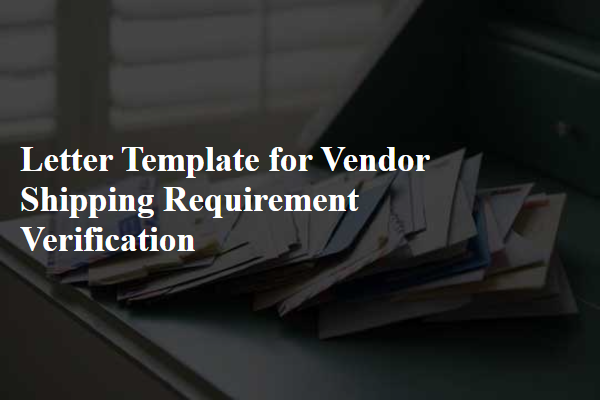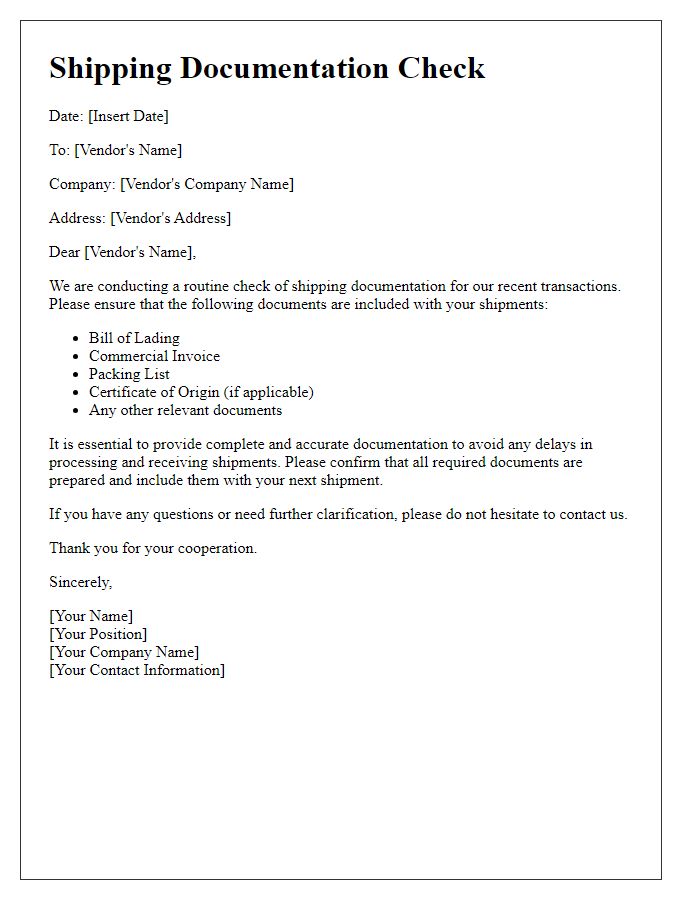Hey there! If you're looking to ensure that your vendor's shipping requirements are up to par, you've come to the right place. It's crucial to have a solid understanding of what's expected during the shipping process to avoid any hiccups down the line. In this article, we'll dive into some essential tips and a handy letter template that can help you verify these requirements effectively. So, let's get started!

Clear contact information
Clear contact information is essential for vendors to ensure accurate shipping and communication regarding package delivery. Key elements include the company name of the vendor, detailed address (including street number, city, state, and zip code), and primary contact person along with their role or title in the organization. Phone numbers should be specified, indicating whether they are mobile or landline, and an email address for quick digital communication. Additional specifications like preferred contact times or alternate contacts can enhance clarification. This information helps to avoid delays, errors, or miscommunication during the entire logistics process, promoting a smoother experience for both vendor and recipient.
Detailed shipping instructions
Shipping instructions provide essential guidelines for successful delivery between vendors and clients. Properly labeled packages should include purchase order numbers, ensuring accurate processing by logistics teams. Shipping documentation must incorporate weight measurements, dimensions, and hazardous materials identification if necessary. Delivery addresses must adhere to specifications, such as including suite numbers or specific dock locations, to facilitate smooth unloading processes. Preferred carriers or shipping methods should be outlined, along with tracking protocols to monitor shipment progress effectively. Communication channels must be established for updates or emergencies, ensuring prompt resolutions in case of unexpected delays. Adherence to these instructions promotes efficiency and reduces shipping errors, ultimately enhancing vendor-client relationships.
Vendor compliance checklist
A vendor compliance checklist serves as a crucial tool in verifying adherence to shipping requirements. It includes key elements such as packaging standards, specified dimensions for freight, and labeling accuracy. Critical information pertains to transportation regulations under organizations like the International Air Transport Association (IATA) and the Federal Aviation Administration (FAA). Compliance with hazardous material shipping rules, including the United Nations (UN) classifications, is also mandatory. Verification of documentation, such as the Bill of Lading and commercial invoices, ensures efficient customs clearance. Timeliness in shipping, often defined as delivery within predetermined lead times--usually ranging from 48 to 72 hours--is essential for maintaining supply chain integrity. Regular audits of vendor shipping processes can further solidify compliance and foster operational excellence.
Delivery timeline and deadlines
Delivery timelines are critical in vendor shipping requirements, influencing overall project efficiency. For instance, standard shipping times in the United States range from 1 to 7 business days, varying based on distance and shipping method. Deadlines impact inventory management and customer satisfaction, emphasizing the need for precise delivery forecasts. Specific events, such as product launches or promotional sales, may necessitate expedited shipping, often requiring a turnaround of 24 to 48 hours. Accurate tracking systems and communication protocols between vendors and clients are essential, ensuring timely updates on shipment status. In addition, compliance with regional regulations and customs requirements can further affect delivery schedules, making it imperative for vendors to adhere to agreed timelines.
Confirmation request and follow-up details
Vendor shipping verification is essential for maintaining supply chain efficiency within businesses. Accurate documentation of shipping requirements, including item specifications, expected delivery dates, and shipping methods, is crucial for avoiding delays. A reliable vendor, such as those operating within the North American logistics sector, should provide transparent updates during the shipping process. Effective communication, particularly for international shipments involving customs clearance and tariffs, can prevent potential disruptions that might arise from missing information. Regular follow-ups can help ensure all requirements are met and allow for timely adjustments to schedules, fostering strong vendor relationships.













Comments